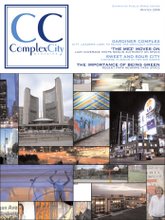Crystal carbuncle
 BY SEAN PEARCE
BY SEAN PEARCE
Toronto is constantly evolving as a city and a prime example of this evolution is the Royal Ontario Museum. At the end of construction, the old architecture of the ROM will be melded with a new crystalline structure designed by Daniel Libeskind, who designed the Jewish Museum in Berlin. In the urban jungle our buildings make up most of the public viewing experience and Toronto takes great pride in this area. But not everyone is pleased with how things are changing.
Robert Brown, membership chair of The Annex Residents’ Association, isn’t impressed with the construction happening at the ROM. According to Brown, Annex residents were told the renovations would be in the same vein as I. M. Pei’s Pyramide du Louvre in Paris. The reality has been quite different.
“My personal view is that it is not what we were told it was originally going to look like,” Brown said. “It’s a much heavier construct than what was originally communicated to the public; this thing looks like a carbuncle.”
Brown also complains that, in his opinion, the more recent additions to Toronto’s architectural landscape, in areas such as the Annex, add little and often completely contradict what is already there.
“There’s no sense of consistency and they’re adding their own architectural vocabulary,” Brown said. “Look at the buildings that have been built in the last 10 years, they’re all just big glass buildings.”
Brown says beyond the fact that some new projects don’t fit the area they’re constructed in, building uniform glass towers across the city leads to a loss of identity for Toronto.
“If you just saw pictures of them and you were asked to identify where they were located you would say, ‘Those could be from anywhere in the city or Hong Kong or Minneapolis or wherever,’” he said. “You’ve got to add something to the overall architectural texture of the city rather than another glass tower.”
In Brown’s opinion, more must be done to preserve the look of an area, such as the Annex, even if that only means keeping a building’s street level face familiar.
James Brown is an architect with the firm Brown and Storey. He sees a real lack of vision in the city and believes the things that are changing are happening too minutely to really matter.
“I don’t think (the city is) doing enough planning and I don’t think they are taking it seriously enough,” Brown said. “You have to do it on a large scale.”
Brown said that many European cities are vastly outpacing Toronto in terms of architectural achievement and cited two examples in particular.
“We just came back from Portugal and Spain and these places are reinventing themselves,” he said. “They’re really thinking long-term.”
Another issue that Brown mentions is the increasing inconsistency in new buildings across the city.
“I don’t think there are any rules anymore,” Brown said. “When you look at the city it’s built kind of like a big fractal puzzle.”
Architect James Brown agrees with Robert Brown that balancing the past and the future is important. He says that buildings are extremely important in the creation of an urban environment.
“You have to try to find a balance and a total overall environment solution when you’re designing these things,” Brown said. “It’s not just about how the buildings look.”
Myron Boyko, senior urban designer with the City of Toronto, said that deciding what does or doesn’t fit architecturally in a certain area is difficult because tastes are so subjective. Still, he thinks the city does its best to keep some uniformity where possible.
“It’s a very subjective issue first of all, as it really depends who the observer is,” Boyko said.
Boyko says that a good example of consistency in architecture is in the area around King Street and Spadina Avenue. In that case an actual plan was adopted.
“(The plan) was to try to preserve the character of that area so that when a developer goes in there, he can’t just tear things down and put in whatever he or she thinks is appropriate,” he said. “Generally we try to work with what’s there.”
As for the ROM, Boyko likes it, but he concedes it might not be for everyone.
“If you look at that building it’s like a clash of cultures and styles, yet I think that’s going to be a very great experience just walking around that building,” he said. “It’s not something you’d expect because it is totally off the wall.”
He adds that the Official Plan, the Toronto of the future, is almost completely uncharted in terms of its architecture. Boyko said the city isn’t sure how it will look.
“(The Official Plan) gives you an idea for where the city might be going, but there’s no real image of what the city is going to look like,” Boyko said. “You can get an impression of what it might be, but that will be based on a site-by-site basis.”





No comments:
Post a Comment